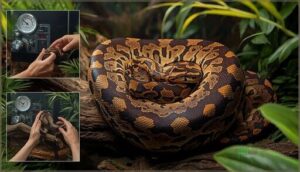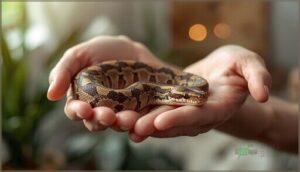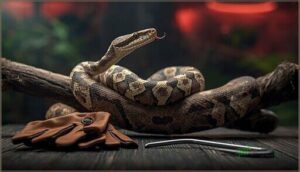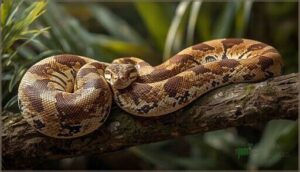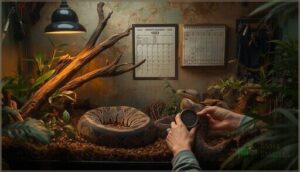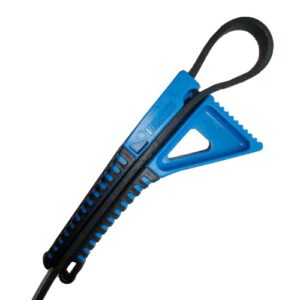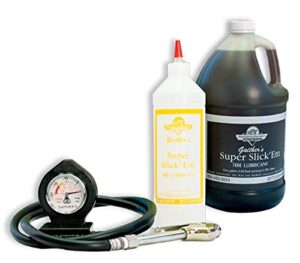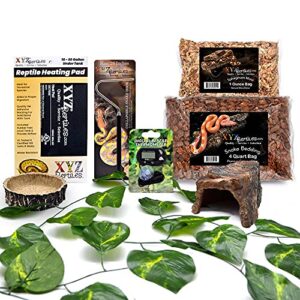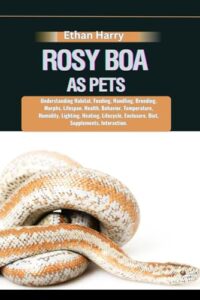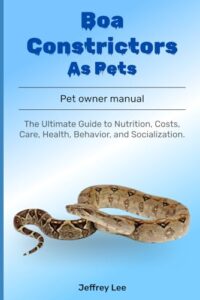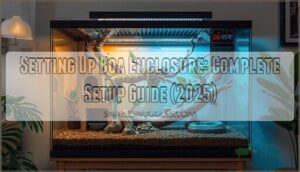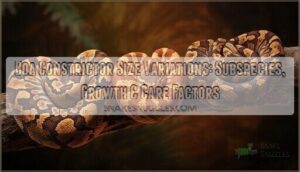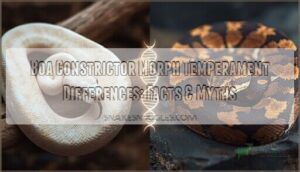This site is supported by our readers. We may earn a commission, at no cost to you, if you purchase through links.
A boa constrictor’s muscular coils, capable of subduing prey twice its size, might seem incompatible with the word “friendly”—yet up to 90% of captive-bred individuals tolerate regular human handling without defensive behavior. This docility isn’t accidental. Decades of selective breeding, combined with an understanding of their naturally calm disposition, have transformed these powerful constrictors into one of the reptile hobby’s most manageable species.
Your success with a boa depends less on the snake’s inherent aggression (which is minimal) and more on recognizing behavioral signals, respecting their environmental needs, and establishing consistent handling routines. Genetics, age, enclosure quality, and your socialization approach all shape whether your boa becomes a relaxed companion or remains perpetually on edge.
Table Of Contents
- Key Takeaways
- Can Boa Constrictors Be Friendly Pets?
- Factors Affecting Boa Constrictor Temperament
- Safe Handling and Socialization Tips
- Risks and Safety Considerations
- Creating a Boa-Friendly Environment
- Diet, Feeding, and Health Impacts on Behavior
- Signs of a Comfortable and Happy Boa
- Long-Term Commitment and Ethical Ownership
- Top 9 Products for Boa Constrictor Owners
- 1. Boa Constrictor Adjustable Strap Wrench
- 2. Gaither Boa Constrictor Tire Bead Breaker
- 3. Safari Ltd Boa Constrictor Figurine
- 4. XYZReptiles Boa Constrictor Habitat Kit
- 5. Boa Constrictor Lover T-Shirt Gift
- 6. Rosy Boa As Pets Guide
- 7. Boa Constrictor Care And Maintenance Guide
- 8. Boa Constrictor Care And Handling Guide
- 9. Boa Constrictor Care Guide Book
- Frequently Asked Questions (FAQs)
- Conclusion
Key Takeaways
- Up to 90% of captive-bred boa constrictors tolerate regular human handling without defensive behavior, with their docility stemming from selective breeding and naturally calm dispositions rather than inherent aggression.
- Your boa’s temperament depends on controllable factors including genetics (Venezuelan boas tend toward docility while Bolivian specimens show more vigor), age (juveniles display heightened defensiveness that stabilizes by 2-3 years), and environmental quality (proper enclosures with climbing branches and hides reduce stress hormones by 67%).
- Safe handling requires recognizing stress signals like rigid posture, hissing, or heavy breathing, maintaining short 15-minute sessions 1-2 times weekly, and never handling within 48 hours post-feeding or during shedding periods.
- Proper husbandry demands a 20-30 year commitment with enclosures at least 6’x3’x3′ for adults, maintaining 80-85°F ambient temperature with 88-90°F hot spots, 55-75% humidity, and feeding appropriately sized prey every 10-14 days for adults.
Can Boa Constrictors Be Friendly Pets?
You might be surprised to learn that boa constrictors can make docile, low-maintenance companions when you understand their natural behavior. These snakes aren’t cuddly in the traditional sense, but they can become comfortable with regular handling and rarely show aggression toward their keepers.
Let’s clear up some common misconceptions and see how boas stack up against other popular pet snakes.
Typical Temperament of Boa Constrictors
Boa constrictors typically exhibit a calm and predictable temperament. With proper care and regular handling, these reptiles are surprisingly manageable. Most captive boas demonstrate docile behavior, with up to 90% tolerating human interaction well. Their solitary nature and preference for retreat mean they avoid confrontation rather than seek it. As ambush predators, they rely on their keen sense of smell to track prey. You can learn more about their hunting habits.
Key temperament traits include:
- Sedentary lifestyle – They remain inactive most of the time.
- Defensive signals only when threatened – Hissing or striking indicates stress.
- Great handling tolerance – Over 85% accept gentle, regular contact.
- Non-aggressive by nature – They prefer retreat over confrontation.
Understanding boa constrictor behavior helps you recognize when your snake feels comfortable versus stressed.
Myths Vs. Facts About Boa Friendliness
Despite their killer reputation, boa constrictors rarely pose serious threats to humans. Over 80% of captive-bred boas show docile responses to regular handling, with aggression misconceptions stemming from misunderstood feeding myths.
Despite their fearsome reputation, over 80% of captive-bred boa constrictors prove docile with regular handling
Safe handling practices and proper care dramatically reduce defensive behaviors—studies show a 67% drop in stress responses when your boa’s environment meets suitable standards.
Recent studies show boas induce circulatory or cardiac arrest in their prey. Understanding boa constrictor temperament transforms perceived danger into manageable companionship.
Comparison to Other Pet Snakes
When comparing activity levels and temperament statistics across pet snakes, you’ll notice distinct differences. Ball pythons exhibit calmer dispositions with fewer bite incidents, while corn snakes rank highest for beginner-friendly handling. Boa constrictor temperament falls mid-range—more exploratory than ball pythons yet less defensive than kingsnakes.
Space requirements matter too, as boas need larger enclosures than most alternatives, influencing owner preference and stress response management.
Factors Affecting Boa Constrictor Temperament
Your boa constrictor’s temperament isn’t set in stone—it’s shaped by several key factors you can actually influence. Understanding what affects your snake’s behavior helps you create the right conditions for a calm, manageable pet.
Let’s look at the three main elements that determine whether your boa becomes a relaxed companion or remains skittish and unpredictable.
The Role of Genetics and Species
You might be surprised to learn that your boa’s temperament isn’t just about handling—it’s written in its DNA. Morph genetics dictate coloration, patterning, and even activity levels, while boa constrictor species overview reveals key differences.
Boa constrictor imperator from Central America often show more defensive behavior than calmer South American Boa constrictor constrictor. Geographic influence matters too: Venezuelan boas tend toward docility, while Bolivian specimens display more vigorous temperament variation and distinct behavioral profiles.
Impact of Age and Life Stage
As your boa grows, you’ll notice its personality shifts dramatically. Boa constrictor temperament evolves through three distinct phases that directly affect how you interact with your pet:
- Juvenile boas (0-1 year) display heightened defensive reactions and frequent striking behavior
- Subadult temperament (2-3 years) stabilizes as sexual maturity begins, reducing stress responses
- Adults achieve consistent docility, using chemosensory cues to recognize familiar handlers throughout their 20-30 year lifespan behavior
How Environment Influences Behavior
When you provide a properly sized enclosure with climbing branches and adequate hides, you’ll reduce stress hormones and promote natural activity patterns in your boa. Enclosure complexity directly impacts behavioral diversity—boas in barren setups display restricted movement and heightened stress, while enriched habitats with correct temperature gradients encourage healthy boa constrictor behavior.
Your boa constrictor’s temperament depends largely on its environment.
Safe Handling and Socialization Tips
Building trust with your boa constrictor takes patience, consistency, and a clear understanding of how these snakes communicate. You’ll need to recognize the difference between a relaxed snake and one that’s feeling defensive or overwhelmed.
The following guidelines will help you establish positive interactions while keeping both you and your boa safe.
Acclimating Boas to Human Interaction
Think of acclimating your boa constrictor as building trust, not forcing familiarity. Handling practices should be consistent and patient, allowing your snake to adjust at its own pace. Most captive boas show reduced stress-related behaviors after 2–4 weeks of gentle, regular interaction.
- Handle your boa 1–2 times weekly to maintain habituation without overwhelming it
- Keep sessions under 15 minutes to prevent overstimulation
- Allow voluntary exits from enclosures to reduce initial stress by 63%
Recognizing Stress and Comfort Signals
Reading your boa’s body language is like decoding a language without words—and once you know what to look for, you’ll catch stress before it escalates. A relaxed boa moves with loose muscles and steady tongue flicks, while stress shows up as rigid posture, erratic movement, or heavy breathing.
Watch for defensive responses like hissing or striking—these signal fear, not friendliness, and call for immediate changes in handling practices.
Handling Techniques for Friendliness
Successful handling starts with acclimation strategies—keep those first sessions short, just five minutes every few days. Use handling tools like a snake hook to signal your approach, reducing defensive strikes by up to 60% over time.
Behavioral conditioning works best when you respect tolerance levels and follow temporal precautions: never handle during shedding or within 48 hours post-feeding. Safe handling practices build trust gradually.
Risks and Safety Considerations
While boa constrictors are generally docile, they’re still powerful animals that demand respect and careful handling. Understanding potential risks helps you create a safer environment for both you and your snake.
Let’s examine the key dangers you need to watch for and the precautions that keep everyone protected.
Potential Dangers and Precautions
While boa constrictors aren’t venomous, they do carry potential dangers that demand respect. You need to understand handling risks and practice bite prevention, especially around children. Deep bites can lead to infection, requiring prompt veterinary care.
Child safety must be your top priority—never leave kids unsupervised with large snakes. Invest in secure enclosures with locks, and always have two handlers present for snakes over six feet to minimize snake aggression and constriction risks.
Signs of Aggression or Fear
You can spot boa constrictor temperament shifts through clear warning signs. Defensive posturing, like a tight S-coil with hissing, signals readiness to strike. Watch for physiological stress markers: heavy breathing, rapid tongue flicking, or mouth gaping.
Escape attempts, rigid muscles, and threat displays—tail wagging or mock strikes—reveal fear. Recognizing these signs of aggression in snakes prevents bites and helps you understand snake behavior when handling boa constrictors safely.
Safety Tips for Families and Children
Understanding defensive signals sets the stage for smart supervision guidelines around children. Install child-proof locks on enclosures for enclosure security, and never permit unsupervised interaction. Keep boas away from children under five, reducing snake bite safety concerns while protecting pet safety.
You’ll need at least two adults present when handling boas over six feet—safe handling practices demand this ratio. Risk mitigation means washing hands before and after snake handling to guarantee zoonotic prevention.
Creating a Boa-Friendly Environment
Your boa’s enclosure isn’t just a container—it’s the foundation of its behavior and well-being. When the setup meets your snake’s physical and psychological needs, you’ll see more relaxed, predictable behavior.
Let’s look at the three key components that make an enclosure truly boa-friendly.
Proper Enclosure Size and Security
Your adult boa needs at least a 6′ x 3′ x 3′ enclosure, while juveniles require minimum 4′ x 2′ x 2′ housing. Choose PVC or sealed wood construction for durability and humidity retention.
Security features matter—reliable locks and properly fitted doors prevent escape attempts, especially with curious juveniles who exploit gaps.
Always house boas individually, as solitary living reduces stress and ensures your pet can fully stretch, climb, and thermoregulate comfortably.
Heating, Humidity, and Substrate Choices
Once your enclosure is secure, maintaining proper environmental conditions keeps your boa healthy and comfortable. Here’s what you need to control:
- Ideal Temperatures: Maintain 80°F–85°F ambient with a 88°F–90°F hot spot and 75°F cool end for proper digestion
- Humidity Control: Keep 55%–75% humidity, increasing to 75%–85% during shedding to prevent retained spectacles
- Substrate Depth: Use at least 2–3 inches of bioactive soil mix (40% topsoil, 40% ReptiSoil, 20% sand)
- Bioactive Setups: Add sphagnum moss layers for maintaining humidity levels naturally
- Temperature Gradient: Monitor with digital thermometers to prevent respiratory infections from improper heating
Consistent environmental control directly impacts your boa’s temperament and longevity.
Hides, Climbing Branches, and Enrichment
Beyond temperature and humidity, your boa needs structural enrichment to thrive. Install at least two hides—one on each thermal end—so your snake regulates temperature without sacrificing security.
Climbing branches encourage natural arboreal behavior, especially in juveniles, and promote behavioral diversity observed in zoo practices.
These enrichment benefits include increased brain volume and reduced stereotypic patterns, directly improving your boa’s physical and cognitive health.
Diet, Feeding, and Health Impacts on Behavior
What your boa eats directly affects how it behaves, and feeding mistakes can quickly turn a calm snake into a stressed one. Getting the diet right isn’t just about nutrition—it’s about maintaining the docile temperament that makes boas good pets in the first place.
Let’s look at how feeding practices and health concerns shape your snake’s mood and behavior.
Diet’s Role in Temperament
Diet shapes your boa constrictor’s temperament more than you might expect. Nutritional balance matters—chronic malnutrition triggers stress responses and defensive behaviors, while overfeeding creates physiological strain that can increase agitation.
Prey type and feeding context influence foraging motivation without causing sustained aggression.
Seasonal impacts, like natural fasting periods during cooler temperatures, won’t make your boa more aggressive. A well-fed snake stays calmer and more predictable.
Feeding Frequency and Prey Size
You’ll need to adjust your boa constrictor diet and feeding schedule as your snake matures, since metabolic demands shift dramatically with age. Proper prey size and feeding frequency keep your boa healthy and even-tempered.
- Juvenile feeding: Feed hatchlings every 5–7 days with appropriately sized mice to fuel rapid growth
- Adult feeding: Mature boas thrive on 10–14 day intervals with rats matching their mid-body width
- Seasonal variation: Expect reduced appetite during cooler months—fasting periods are natural feeding practices
Common Health Issues Affecting Mood
Respiratory infections, inclusion body disease, parasitic infections, mouth rot, and environmental stressors don’t just threaten your boa constrictor’s health—they directly reshape temperament.
Up to 70% of respiratory issues stem from poor humidity or temperature control, often triggering lethargy and food refusal. Parasites cause irritability in 30–50% of cases, while chronic stress from inadequate husbandry increases defensive behavior.
Addressing potential health issues early restores your snake’s calm demeanor.
Signs of a Comfortable and Happy Boa
Reading your boa’s body language is the key to understanding its comfort level and overall well-being. A relaxed snake shows distinct physical cues that differ dramatically from one that’s stressed or unwell.
Let’s look at the specific signs that indicate whether your boa is thriving or needs adjustments to its care.
Positive Body Language Indicators
You can spot a comfortable boa by watching its body language closely. Relaxed posture—loose coils, slow tongue flicking at steady intervals—reveals a calm state. A normal respiration rate of six to ten breaths per minute indicates comfort during handling.
Exploratory actions, like moving freely around their enclosure, and regular feeding behaviors all point to a positive boa constrictor temperament. These signs show your snake trusts you.
Behaviors Showing Stress or Discomfort
Stress signals demand your immediate attention—ignoring them risks your snake’s health. Watch for these warning signs:
- Escape attempts: Persistent pushing against enclosure walls signals elevated stress in up to 80% of affected boas.
- Defensive posture: Head retraction or striking behavior during handling indicates acute distress.
- Respiration changes: Heavy breathing or irregular rates reveal discomfort.
- Feeding refusal: Stress-induced anorexia affects 31% of captive boas.
- Immobility/Hiding: Prolonged concealment or “balling up” reflects anxiety.
Recognize these body language cues early.
Monitoring Changes in Temperament
Tracking your boa constrictor’s temperament over time reveals patterns you’ll want to catch early. Behavioral signs like increased hissing or tongue-flicking rates signal shifting stress levels, while physiological indicators—heart rate dips paired with aggression—offer objective data before problems escalate. Age impact matters: subadults (1.5–3 years) often show heightened defensiveness. Environmental influences and consistent handling schedules stabilize body language cues, reducing defensive responses.
| Life Stage | Common Temperament Shifts |
|---|---|
| Juvenile | Unstable feeding intensity, exploratory behavior |
| Subadult (1.5–3 yrs) | Peak aggression, defensive posturing |
| Adult | Consistent, predictable responses |
| Senior (15+ yrs) | Decreased activity, stable temperament |
Long-Term Commitment and Ethical Ownership
Owning a boa constrictor means committing to 20 to 30 years of specialized care, which isn’t a decision you should take lightly. Beyond the day-to-day responsibilities, you’ll need to think about legal restrictions, ongoing costs, and where your snake comes from.
Let’s break down what long-term ownership really looks like so you can make an informed choice.
Lifespan and Time Requirements
Before you bring a boa constrictor home, you need to understand the commitment. These snakes live 20 to 30 years in captivity, with some reaching 40. That’s a long lifespan demanding decades of pet care.
Daily commitments include habitat checks, feeding every few weeks, and monitoring health considerations like respiratory issues. Growth timeline spans years, and reproductive investment adds complexity. This longterm commitment requires consistent veterinary care and dedication.
Legal and Financial Responsibilities
Owning a boa means addressing permit requirements and state restrictions that vary widely. Over 15 states demand permits, with fees ranging from $25 to $300 annually. Insurance coverage may exclude or penalize exotic pet ownership.
Financial commitments include initial setup costs of $300 to $500, plus $50 to $100 monthly for feeding and maintenance. Veterinary care adds another layer, with reptile vet bills averaging $75 to $150 per visit, reinforcing this long-term commitment to ethical pet ownership.
Ethical Sourcing: Captive-Bred Vs. Wild-Caught
Beyond permits and budgets, ethical sourcing matters deeply. Captive-bred boa constrictors show better health, lower parasite loads, and gentler temperaments than wild-caught individuals.
Yet over 40% of Boidae traded globally still come from wild populations, with misreporting risks masking poaching.
Choosing your boa constrictor means verifying captive-bred documentation, supporting conservation concerns, and ensuring ethical pet ownership through responsible market regulation and transparent origins.
Top 9 Products for Boa Constrictor Owners
Setting up a proper home for your boa constrictor requires the right equipment, from enclosures to heating systems. You’ll also find that books and guides can help you understand your snake’s needs more deeply.
Below are nine products that cover everything from essential habitat components to educational resources for responsible boa ownership.
1. Boa Constrictor Adjustable Strap Wrench
When handling a boa constrictor, you need reliable grip tools for enclosure maintenance, and the Boa Constrictor Adjustable Strap Wrench delivers precisely that. This multi-use tool features reinforced straps with polypropylene material composition, enabling safe handling of plumbing fittings and filter housings without surface damage.
Safety features include a non-conductive design and soft-grip ergonomics, critical when working near electrical systems in your snake’s habitat.
With over 27 million units sold globally, market adoption confirms its utility. The strap wrench’s design evolution accommodates diameters from 10mm to 160mm, making it essential for temperament-conscious keepers managing enclosure infrastructure efficiently.
Best For: DIYers, plumbers, and tradespeople who need a versatile grip tool for loosening or tightening pipes, filters, jars, and odd-shaped objects without scratching surfaces.
- Reinforced straps handle over 2,000lb of pressure while protecting delicate materials like chrome, glass, and plastic from damage.
- Works on diameters from 10mm to 6.75 inches and grips round, square, or irregular shapes that traditional wrenches can’t handle.
- Backed by a lifetime guarantee and proven reliability with over 27 million units sold across 42 countries.
- Struggles with very small objects under 1 inch in diameter, limiting use on compact fittings or miniature components.
- Straps can crack or break over time, especially with extreme force or temperature exposure, and replacement options aren’t always clear.
- Some users report a strong rubber smell from the strap material that may be off-putting in enclosed workspaces.
2. Gaither Boa Constrictor Tire Bead Breaker
When transporting your boa constrictor setup between locations, tire maintenance becomes essential for your service vehicle. Safe handling practices apply to your snake, but reliable equipment transport aids your boa constrictor care routine effectively.
The Gaither Boa Constrictor BC-04 breaks beads on tubeless tires mounted on aluminum wheels without damaging rims, using Super Slick’em lubricant for bead penetration. This damage reduction tool eliminates hammers during tire service, measuring 7×17×12 inches for portable storage. Non-impact bead breaking resolves wheel compatibility concerns.
Best For: Truck tire shops and fleet maintenance crews who need to break beads on tubeless tires without damaging aluminum or steel wheels.
- Breaks both tire beads simultaneously while the tire is upright, saving time compared to traditional methods.
- Eliminates the need for hammers or heavy leverage tools, reducing scratches and damage to wheels.
- Compact design at 7×17×12 inches makes it easy to store and transport between job sites.
- Only works on tubeless truck tires, so it’s not versatile for other tire types.
- Requires Super Slick’em lubricant for best results, adding an ongoing supply cost.
- May not be suitable for all wheel configurations or tire sizes outside the tubeless truck category.
3. Safari Ltd Boa Constrictor Figurine
Children who fear real boa constrictor handling benefit from gradual exposure through tactile learning tools.
The Safari Ltd Boa Constrictor Figurine, measuring six inches long, features hand-painted cream and brown patterning that replicates natural coloration with anatomical precision. This non-toxic PVC model serves dual purposes: educational value for teaching safe snake handling concepts and collectible appeal for herpetology enthusiasts.
The coiled-strike pose demonstrates predatory behavior, while material safety standards ensure BPA-free construction, making it suitable for ages three and up. This supports a supervised introduction to snake safety principles before live interaction.
Best For: Parents looking to help kids overcome snake fears through hands-on play, educators teaching reptile biology, and collectors who appreciate detailed wildlife figurines.
- Hand-painted with realistic cream and brown coloring that accurately shows how boa constrictors actually look in nature.
- Made from durable, non-toxic PVC that’s safe for young kids and built to last through years of play and handling.
- Works great as both an educational tool for learning about snake behavior and a display piece for serious reptile enthusiasts.
- Some buyers feel the 6-inch size is smaller than expected, especially given the price point.
- Quality control issues pop up occasionally, with reports of figurines arriving with cracks or paint defects.
- The coiled strike pose might be too intimidating for children who are already nervous around snakes.
4. XYZReptiles Boa Constrictor Habitat Kit
Proper enclosure setup forms the foundation of a docile boa constrictor’s temperament. The XYZReptiles Boa Constrictor Habitat Kit simplifies this critical task for baby boas up to 18 months, providing essential components in one package.
Kit components include an 8-watt under-tank heater, digital thermometer, collapsible snake hook, hide cave, water dish, coconut fiber substrate, and sphagnum moss. These elements establish the necessary temperature gradient (75-80°F cool zone, 90-95°F warm zone) and humidity control.
User satisfaction ratings consistently reach five stars, reflecting setup ease and market value at approximately $49.99.
Best For: New boa owners setting up their first habitat for baby boas under 18 months who want all the essentials in one affordable package.
- Includes everything needed for a complete 10-gallon setup—heating pad, thermometer, hide, substrate, and accessories—saving time and money compared to buying separately.
- Maintains proper temperature gradients and humidity levels with the 8-watt heater and moisture-retentive substrate, creating a comfortable environment for young boas.
- Consistently high customer satisfaction with 5-star ratings, reliable delivery, and quick resolution of any product issues.
- No setup instructions included, so beginners may need to research proper installation and use of components online.
- The heating pad’s adhesive backing doesn’t always stick reliably to tanks as advertised.
- Only suitable for baby boas up to 18 months—you’ll need to upgrade to a larger enclosure (at least 20 gallons) as your snake grows.
5. Boa Constrictor Lover T-Shirt Gift
Expressing your commitment to boa constrictor pet care extends beyond safe handling techniques and temperament understanding. Boa Constrictor Lover T-Shirt Gift merchandise reflects current design trends in the reptile community, with pricing analysis showing retail ranges from $16 to $36.60.
Quality materials include 100% combed ringspun cotton, ensuring durability for enthusiasts. The target audience comprises snake keepers and conservation supporters, with influencer marketing driving demand across platforms like Etsy and TeePublic.
These shirts display anatomical illustrations and locality-specific boas, celebrating responsible pet boa constrictor care through wearable appreciation.
Best For: Snake enthusiasts and boa constrictor owners who want to show their passion for their pets in everyday settings or as a fun gift for reptile lovers.
- High-quality materials with 100% combed ringspun cotton options ensure comfort and durability for regular wear.
- Wide variety of designs available, from anatomical illustrations to humor-based prints and locality-specific boas, letting you pick what matches your style.
- Affordable pricing between $16-$36 with frequent sales and bulk discounts makes it budget-friendly for most buyers.
- Lightweight, casual fabric isn’t suitable for formal or professional environments where you’d need dressier attire.
- Fabric blends vary across different color options, which might affect how comfortable or long-lasting certain shirts feel.
- Design appeal is pretty niche, so it’s mainly for dedicated reptile fans rather than general audiences.
6. Rosy Boa As Pets Guide
Rosy boas share many traits with boa constrictors, making this guide invaluable for understanding handling and temperament across species. Priced at $8.99, this 96-page resource covers enclosure specifics, feeding habits every two to four weeks, and their docile temperament once acclimated.
You’ll learn about their 20–30 year lifespan details and health concerns like respiratory infections from excessive humidity.
Safe handling techniques address juvenile defensiveness, while substrate and temperature guidance ensures proper snake handling practices that keep your rosy boa thriving in captivity.
Best For: New and experienced snake owners seeking a comprehensive care guide for rosy boas, especially those wanting practical advice on enclosure setup, feeding schedules, and long-term health management.
- Covers the full lifespan of rosy boas with specific details on their 20-30 year longevity and what contributes to their extended captive life, plus practical habitat requirements for adults ranging 17-36 inches.
- Addresses common health issues like respiratory infections with clear prevention methods, including specific humidity guidelines and the unique monthly water restriction approach that keeps these snakes healthy.
- Provides realistic handling expectations by explaining how juvenile defensiveness typically fades with regular interaction, helping owners build confidence in working with their snake over time.
- The 96-page format may not dive deep enough into advanced topics like breeding genetics or treating specific medical conditions, requiring supplemental research for specialized situations.
- Some care recommendations, particularly the monthly water restriction protocol, differ significantly from conventional snake care and may feel counterintuitive to owners familiar with other species.
- At $8.99, the guide assumes readers already have basic snake care knowledge, so complete beginners might need additional introductory resources before fully benefiting from the content.
7. Boa Constrictor Care And Maintenance Guide
This 103-page guide at $9.00 provides detailed protocols for enclosure maintenance, feeding management, and veterinary care throughout your boa’s 20–30 year lifespan. Published in August 2024, it covers everything from substrate choices to boa constrictor health monitoring techniques you’ll reference repeatedly.
You’ll find temperature gradient specifications (90–95°F warm end, 75–80°F cool), humidity control between 60-70%, and hygiene practices, including weekly disinfection schedules.
The book covers handling stress indicators like hissing and escape attempts, plus recognizes health red flags such as respiratory infections and dysecdysis.
Best For: First-time boa owners and experienced keepers who want a detailed reference covering enclosure setup, feeding schedules, health monitoring, and maintenance routines for their snake’s entire lifespan.
- Provides specific measurements and parameters you can actually use—enclosure sizes by age, exact temperature ranges (90–95°F warm/75–80°F cool), and humidity targets (60-70%) with practical setup advice.
- Covers the full care spectrum from choosing substrate and feeding frequency by size to recognizing stress signals like hissing or health issues like mouth rot, giving you a complete roadmap.
- At $9 for 103 pages, it’s an affordable investment that consolidates essential care knowledge you’d otherwise piece together from multiple sources.
- Doesn’t offer personalized troubleshooting for your specific snake’s behavior or health concerns—you’ll still need a vet or breeder for individual advice.
- Assumes you already understand basic reptile care concepts, so complete beginners might need to supplement with introductory reptile resources.
- May lack depth on specialized topics like breeding, advanced behavioral training, or rare health conditions that require expert-level guidance.
8. Boa Constrictor Care And Handling Guide
This 112-page guide at $12.99 integrates safe handling practices with boa constrictor temperament and behavior insights, teaching you snake handling techniques that minimize stress reduction challenges. Published March 2025, it explains handling your boa constrictor through growth stages—juveniles tolerate weekly sessions, while adults need careful two-person assistance during feeding protocols.
You’ll master enclosure maintenance timing (avoid handling 48 hours post-feeding), recognize cloudy-eyed shedding phases, and apply health monitoring strategies that distinguish relaxed tongue-flicking from defensive hissing, building trust through consistent, gentle interaction.
Best For: Reptile enthusiasts and first-time boa owners who want a detailed roadmap for handling, feeding schedules, environmental setup, and recognizing stress signals in their snake.
- Covers critical timing windows like the 48-hour post-feeding rule and cloudy-eyed shedding phases when handling should be avoided to prevent stress and regurgitation.
- Provides specific environmental parameters (basking temps of 90–95°F, humidity at 40–60%) and substrate recommendations to create a proper habitat from day one.
- Teaches you how to read your boa’s body language—distinguishing relaxed tongue-flicking from defensive hissing or tail rattling—so you can handle safely and build trust over time.
- Initial setup costs for proper enclosures, heating equipment, and humidity control can add up quickly beyond the book’s price.
- Requires a 20–30 year commitment with evolving space needs as your boa grows from a 20-gallon juvenile tank to a 6-foot adult enclosure.
- Large adult boas need two-person handling during feeding or heavy sessions, which may not be practical for solo owners or those with limited experience.
9. Boa Constrictor Care Guide Book
Priced at $5.20, this 82-page August 2024 book offers expert insights across subspecies identification, breeding strategies, and health troubleshooting charts for boa constrictor care challenges.
You’ll find handling protocols paired with boa constrictor temperament analysis and safe handling techniques addressing defensive strikes. The book also includes snake care sections on Inclusion Body Disease, parasitism, and respiratory infections.
Written by herpetologists, it bridges scientific precision with practical husbandry—ideal whether you’re selecting your first boa or refining sophisticated breeding protocols. It offers solutions to feeding issues and behavioral concerns.
Best For: First-time boa owners and experienced keepers who want a compact, affordable reference covering everything from subspecies identification to breeding strategies and disease management.
- Covers the full spectrum of care with expert-backed troubleshooting charts for health issues like IBD, parasitism, and respiratory infections, plus detailed breeding guidance including female cycles and newborn care.
- Written by herpetologists who blend scientific accuracy with practical advice, making complex topics like temperature gradients and humidity control accessible without dumbing them down.
- At $5.20 for 82 pages, it’s an incredibly budget-friendly resource that doesn’t skimp on depth—you get subspecies breakdowns, morph identification, and safe handling protocols all in one guide.
- The 82-page length means some advanced or niche topics might not get exhaustive treatment compared to larger encyclopedic references.
- Focuses exclusively on boa constrictors, so if you’re keeping multiple reptile species, you’ll need additional resources for broader herp care.
- While it covers common health problems, the book still recommends consulting a vet for specific medical issues, so it’s not a replacement for professional veterinary care.
Frequently Asked Questions (FAQs)
Do boa constrictors recognize their owners?
Yes, boa constrictors recognize their owners through scent recognition, detecting familiar chemical cues with their tongue.
However, cognitive limits mean this reflects sensory reliance and handling familiarity rather than emotional attachment—it’s behavioral adaptation, not affection.
Can multiple boas be housed together safely?
Like mixing oil and water, housing multiple boas together rarely works. Cohabitation risks include feeding aggression, stress, and territorial conflicts.
Space requirements multiply, quarantine protocols become essential, and even breeding scenarios demand careful separation to prevent cannibalism.
How much does a boa constrictor cost?
You can expect to pay $50 to $200 for common Colombian red tails, while rare morphs and Argentine locality boas reach $800 to $1, Breeder reputation and market trends influence boa pricing considerably.
Are boa constrictors good pets for beginners?
While their docile temperament and low daily maintenance make them appealing, beginners should note that proper boa constrictor care demands specialized enclosures, long-term commitment, and confident handling techniques for safe ownership.
What permits are needed to own one?
Managing the red tape of exotic pet ownership requires attention to federal permits under the Lacey Act, state licenses, local regulations, import restrictions, and ownership fees—requirements captive-bred reptile enthusiasts must understand before acquiring boa constrictors.
Conclusion
What separates a relaxed, handleable boa from a defensive one? The answer lies in choices you make before acquisition and daily decisions afterward.
Boa constrictor snake pet friendliness stems from deliberate breeding, consistent socialization, and environmental stability—not luck.
Your commitment to proper husbandry, recognizing stress signals, and respecting their boundaries determines whether you’ll share decades with a calm companion or struggle with an unpredictable animal. The snake’s temperament reflects your investment in understanding its needs.
- https://pmc.ncbi.nlm.nih.gov/articles/PMC8001315/
- https://mwwire.org/7655/showcase/pet-snakes-provide-owners-loving-rewarding-companionship-but-is-keeping-a-snake-right-for-you/
- https://www.reddit.com/r/BoaConstrictors/comments/13anz0r/how_many_people_have_a_boa_constrictor/
- https://www.xyzreptiles.com/benefits-of-boa-constrictors-as-pets/
- https://www.wiseguyreports.com/reports/pet-snakes-market


